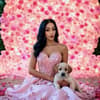Podcast
Questions and Answers
What is the blind spot?
What is the blind spot?
- The outer covering of the eyeball
- The part of the eye that controls light entry
- The place where the optic nerve leaves the retina (correct)
- The area where light is focused
What is the role of the optic nerve?
What is the role of the optic nerve?
Bundle of nerve fibers that carry information from the retina to the brain.
What is the sclera?
What is the sclera?
Thick, tough, white outer covering of the eyeball.
What does the vitreous humor do?
What does the vitreous humor do?
What is the function of the aqueous humor?
What is the function of the aqueous humor?
What is the lens?
What is the lens?
What is the iris?
What is the iris?
What is the cornea?
What is the cornea?
What does the retina do?
What does the retina do?
What is the pupil?
What is the pupil?
What is glaucoma?
What is glaucoma?
What is hyperopia?
What is hyperopia?
What is myopia?
What is myopia?
What are cataracts?
What are cataracts?
Which structures refract light?
Which structures refract light?
What are rods?
What are rods?
What are cones?
What are cones?
What is refraction?
What is refraction?
What is depth perception?
What is depth perception?
What is an afterimage?
What is an afterimage?
What is accommodation?
What is accommodation?
What do the numbers on an eye chart stand for?
What do the numbers on an eye chart stand for?
The pathway light travels through the eye involves the following steps: 1. Enters cornea which refracts (bends) the light, 2. Light passes through the ______, 3. Pupil allows the light into the inner eye...
The pathway light travels through the eye involves the following steps: 1. Enters cornea which refracts (bends) the light, 2. Light passes through the ______, 3. Pupil allows the light into the inner eye...
Flashcards are hidden until you start studying
Study Notes
Anatomy of the Eye
- Blind Spot: Area where the optic nerve exits the retina, lacking photoreceptors.
- Optic Nerve: Transmits visual information from the retina to the brain; composed of bundled nerve fibers.
- Sclera: Tough, white outer layer of the eyeball, providing structure and protection.
- Vitreous Humor: Gel-like substance filling the eye, helps maintain its shape.
- Aqueous Humor: Clear fluid nourishing the eye, crucial for corneal shape retention.
- Lens: Flexible, transparent structure that adjusts to focus images onto the retina.
- Iris: Colored muscular structure regulating light entry; expands and contracts in response to light.
- Cornea: The clear protective layer covering the front of the eye; refracts light as it enters.
- Retina: Light-sensitive inner layer containing photoreceptors; converts light into neural signals.
- Pupil: Central opening of the iris; controls the amount of light entering the eye.
Common Eye Conditions
- Glaucoma: Group of conditions causing optic nerve damage, often due to elevated intraocular pressure.
- Hyperopia (Farsightedness): Difficulty seeing nearby objects; caused by improper bending of light, focusing behind the retina.
- Myopia (Nearsightedness): Difficulty seeing distant objects; caused by light focusing before the retina.
- Cataracts: Clouding of the lens affecting vision, commonly associated with aging; significant in older adults.
Eye Anatomy Functions
- Refraction in the Eye: Only the lens and cornea refract light; the aqueous humor and iris do not.
- Rods: Photoreceptors for low-light vision and peripheral awareness; detect shades of black, white, and gray.
- Cones: Photoreceptors for color vision and fine detail; most concentrated in the center of the retina, sparse in the periphery.
Light Perception and Vision
- Refraction: The bending of light as it passes through different mediums.
- Depth Perception: Ability to judge distances between objects; essential for spatial awareness.
- Afterimage: Visual impression that remains after the original image has disappeared.
- Accommodation: Process whereby the eye adjusts the lens shape to focus on objects at varying distances.
Visual Acuity Testing
- Eye Chart Numbers: Indicate visual acuity; the top number represents the testing distance, while the bottom reflects the distance a person with normal vision can read that line (e.g., 20/20 = normal vision).
Pathway of Light through the Eye
- Light enters through the cornea, refracted to bend it.
- Passes through the aqueous humor before entering the pupil.
- The iris adjusts light entry volume through contraction/expansion.
- Lens refracts light further to focus it on the retina.
- Ciliary muscles fine-tune the focus.
- The light travels through the vitreous humor to the retina.
- Retina processes light and image is captured by rods and cones.
- The optic nerve carries the processed visual information to the brain.
Studying That Suits You
Use AI to generate personalized quizzes and flashcards to suit your learning preferences.





